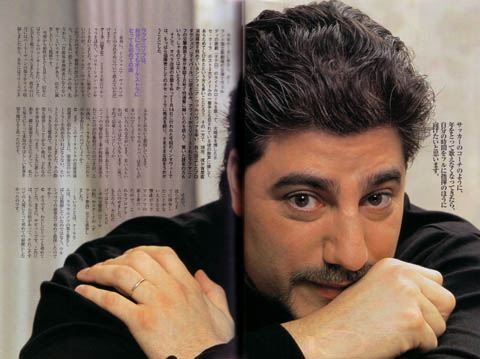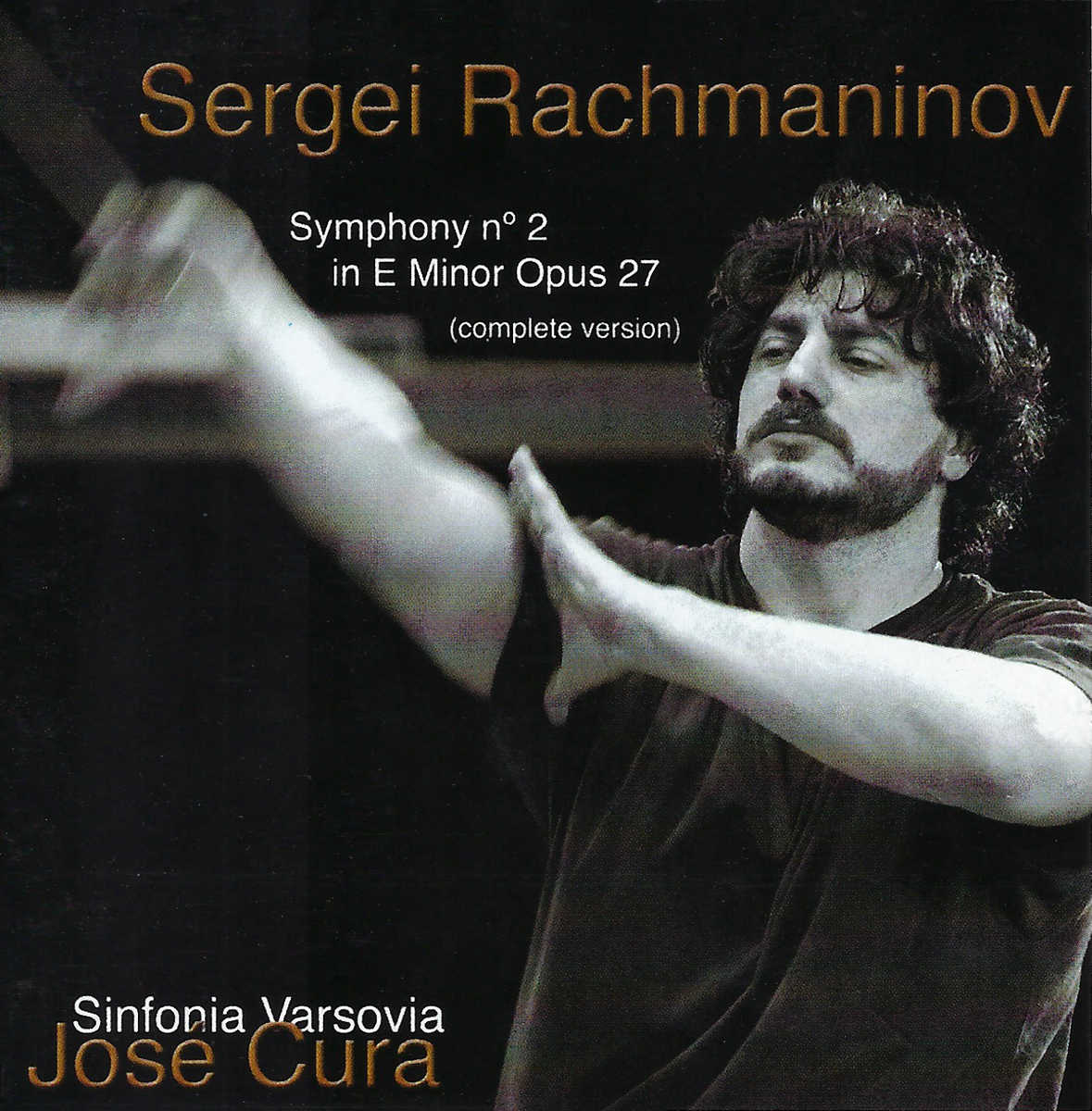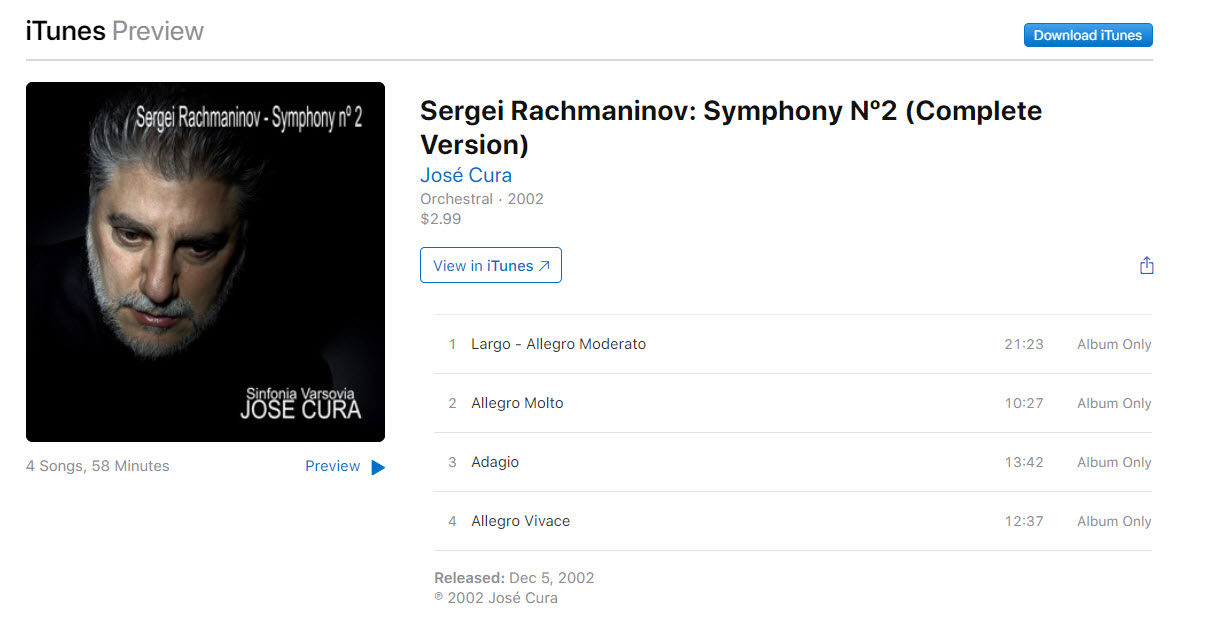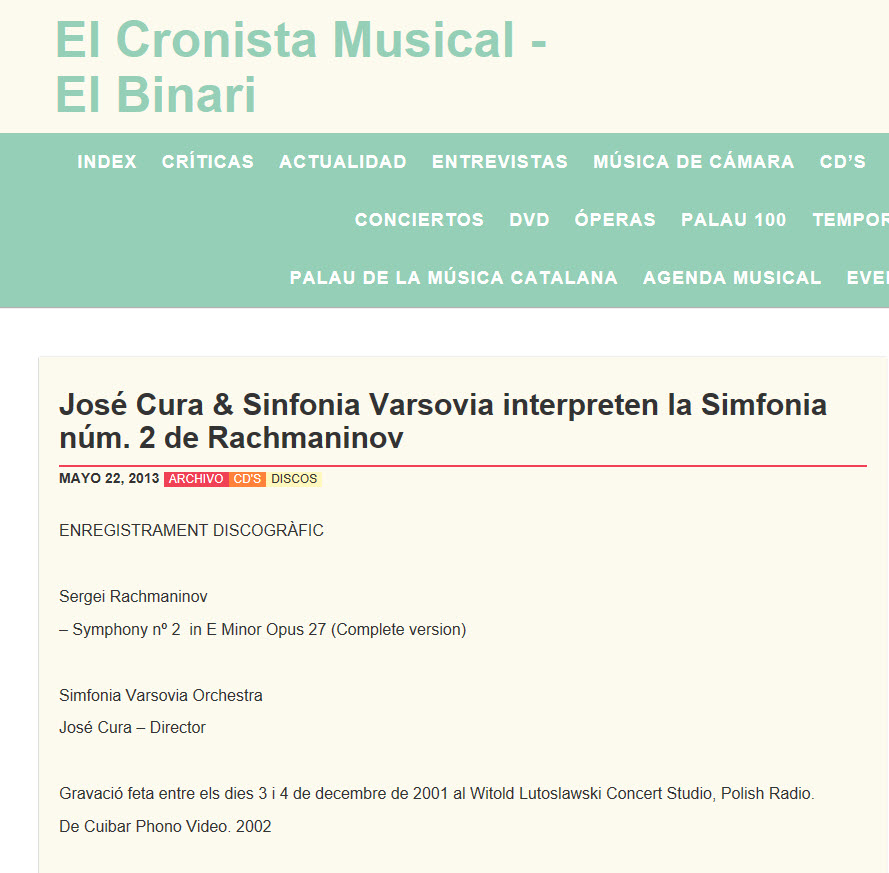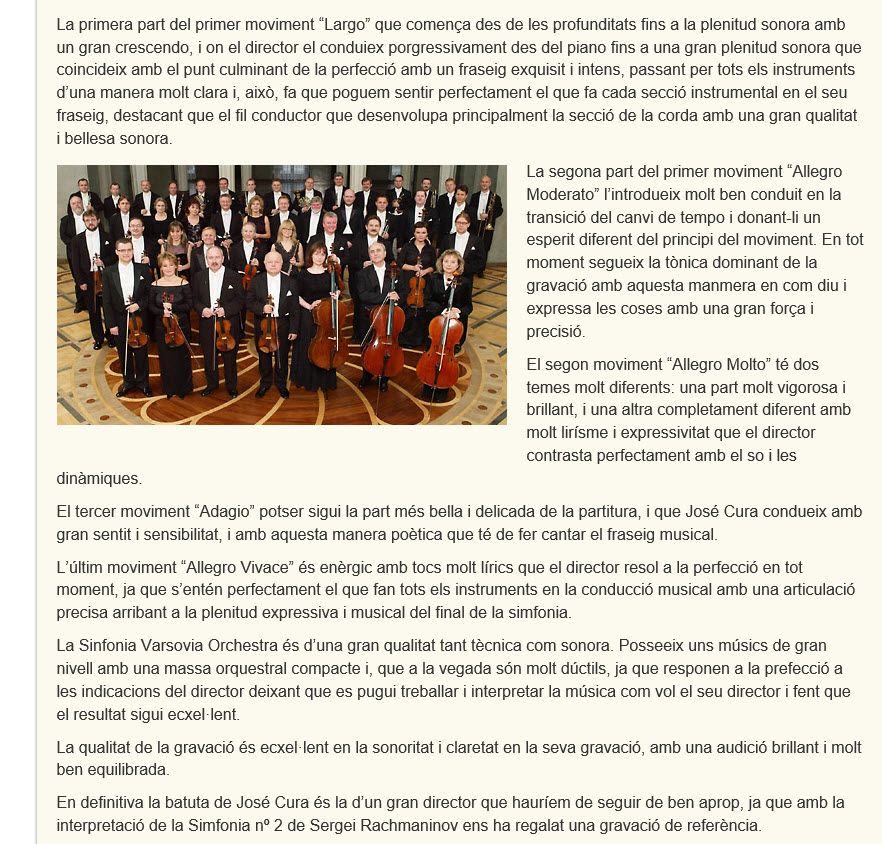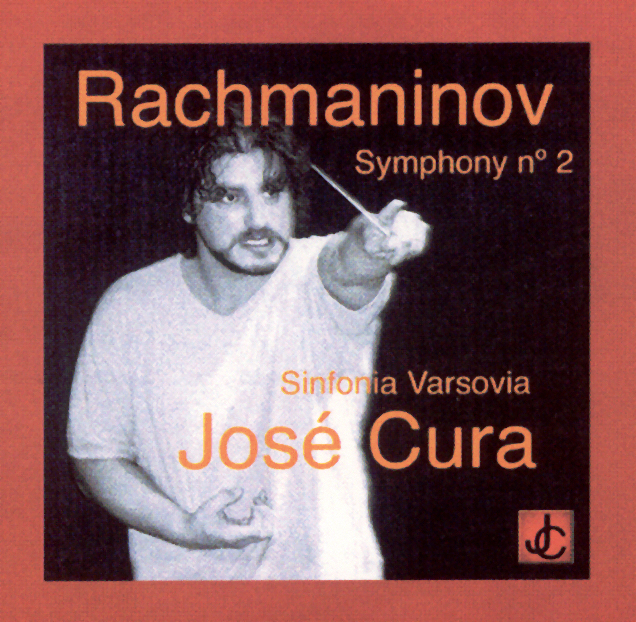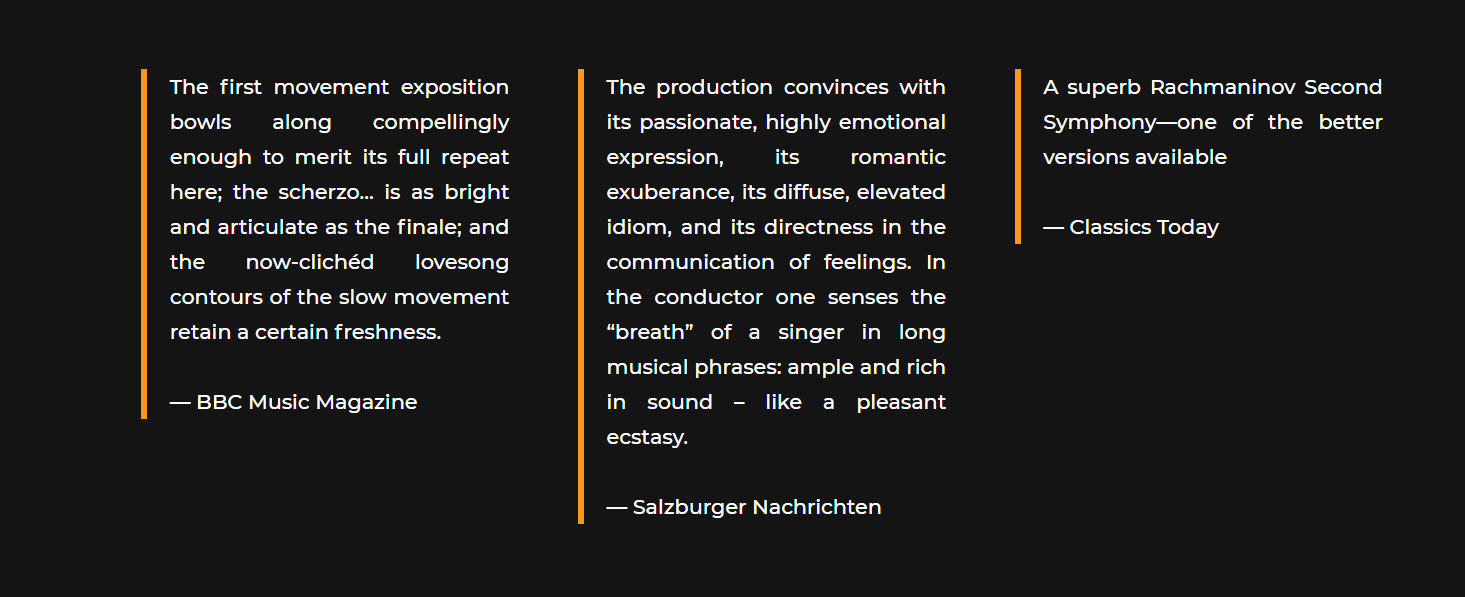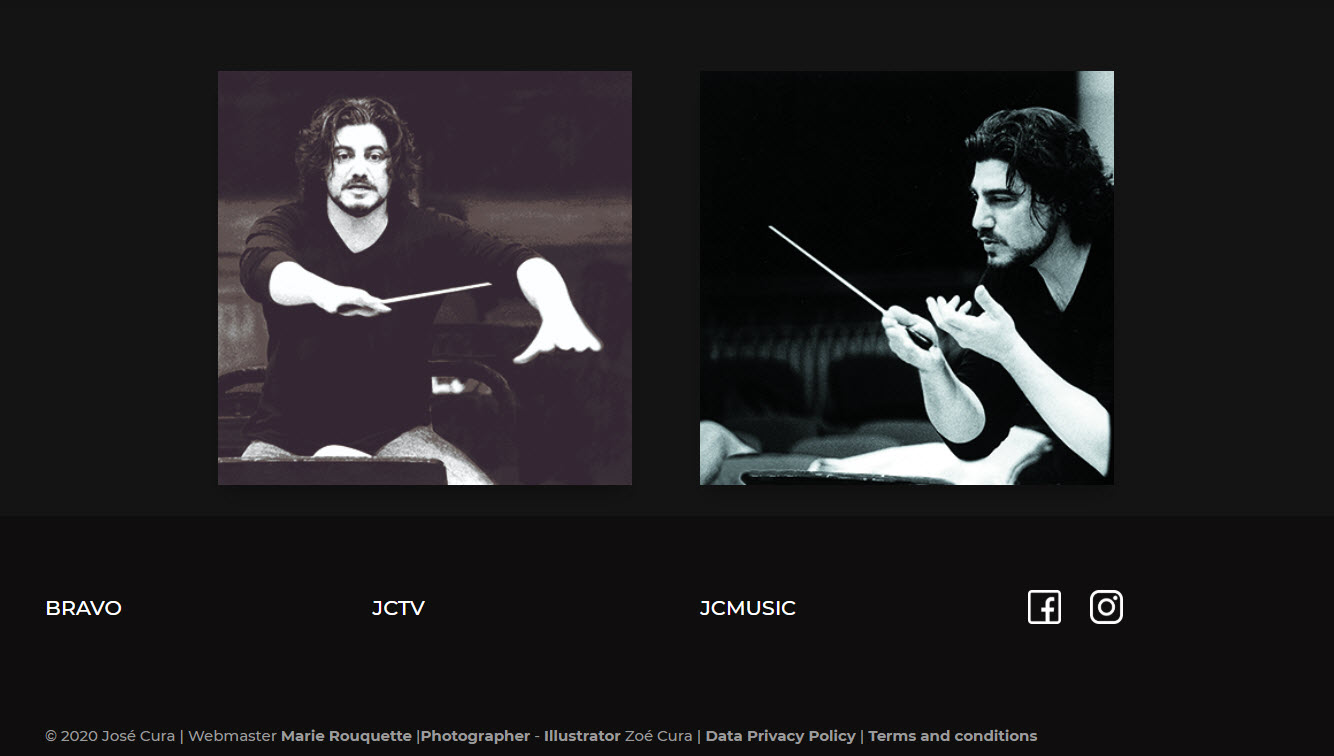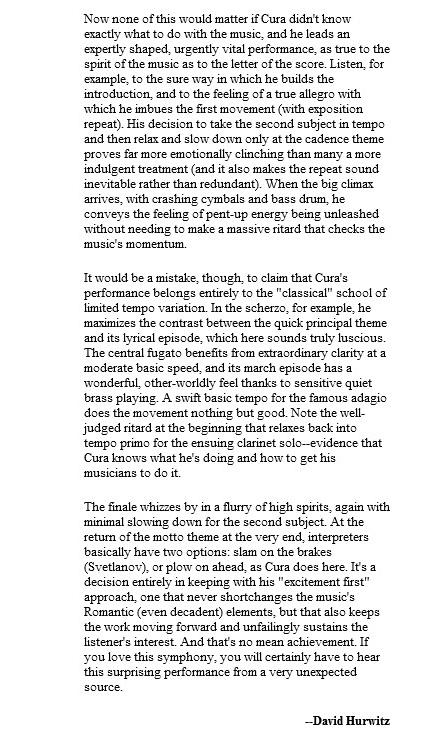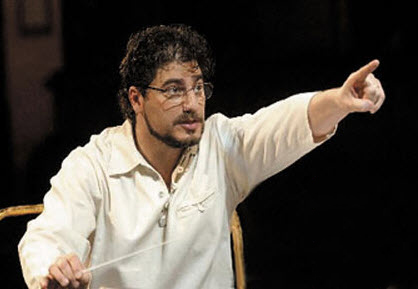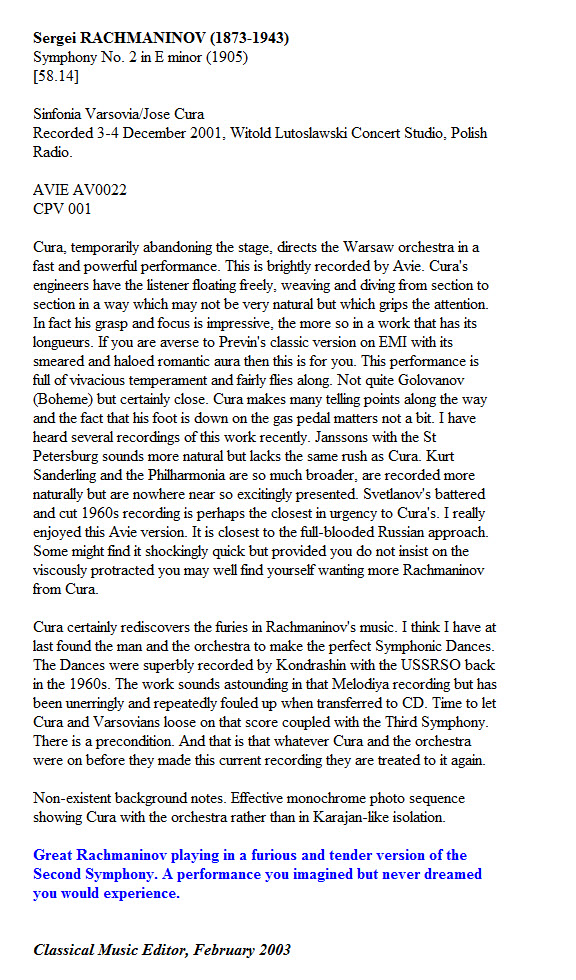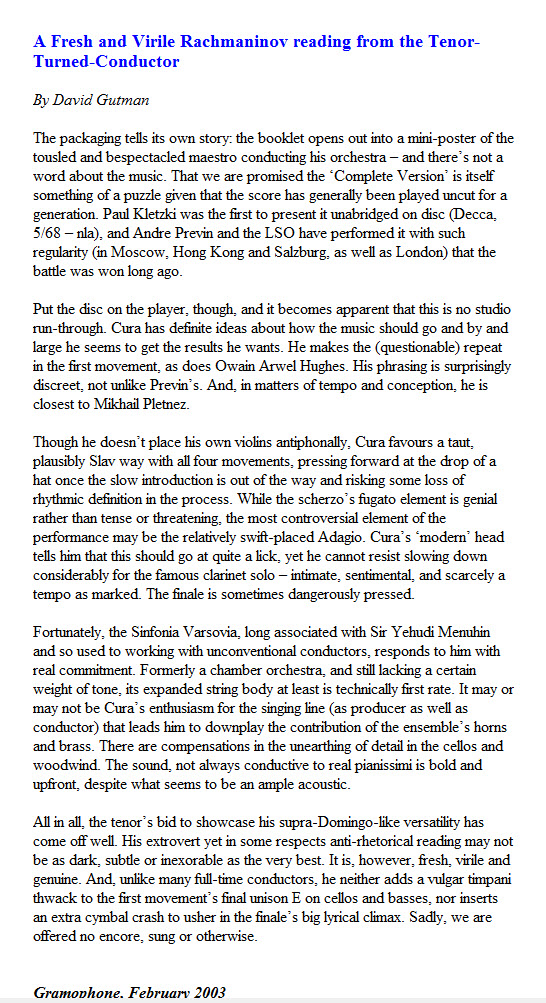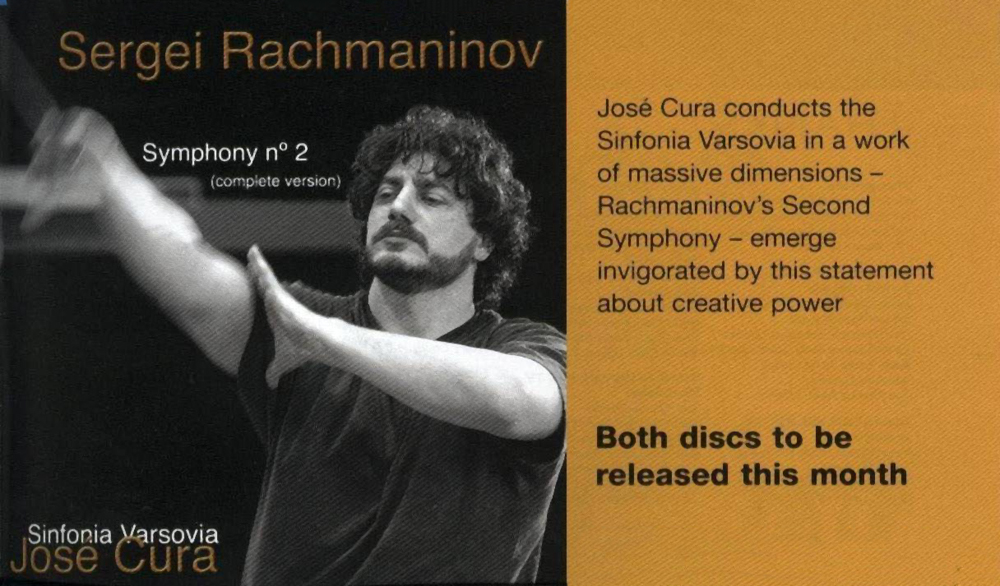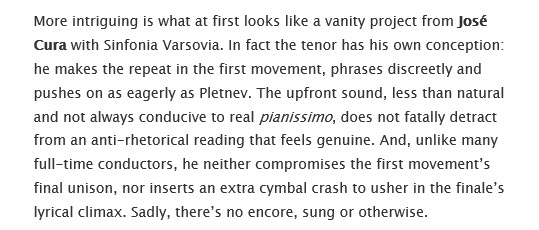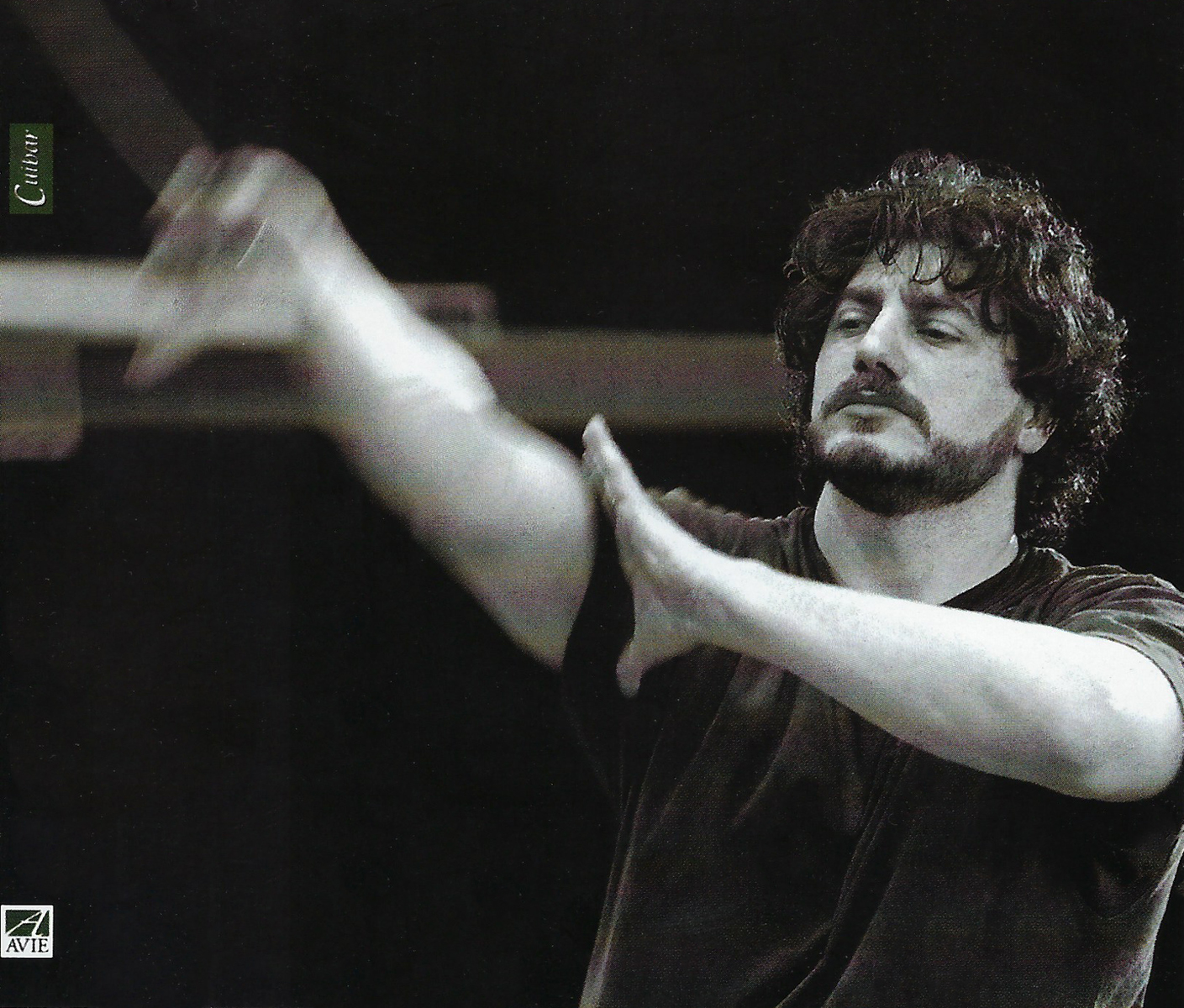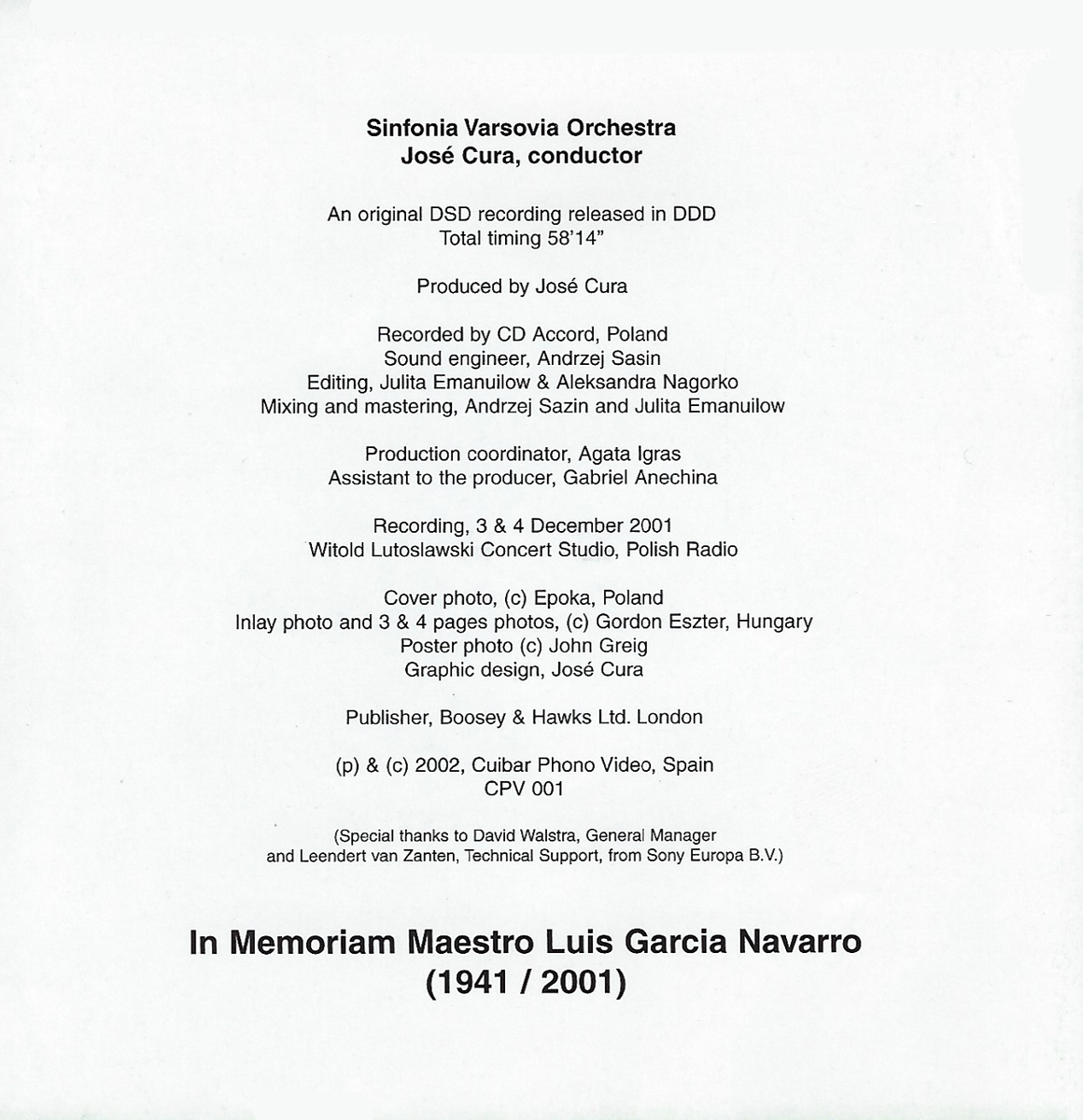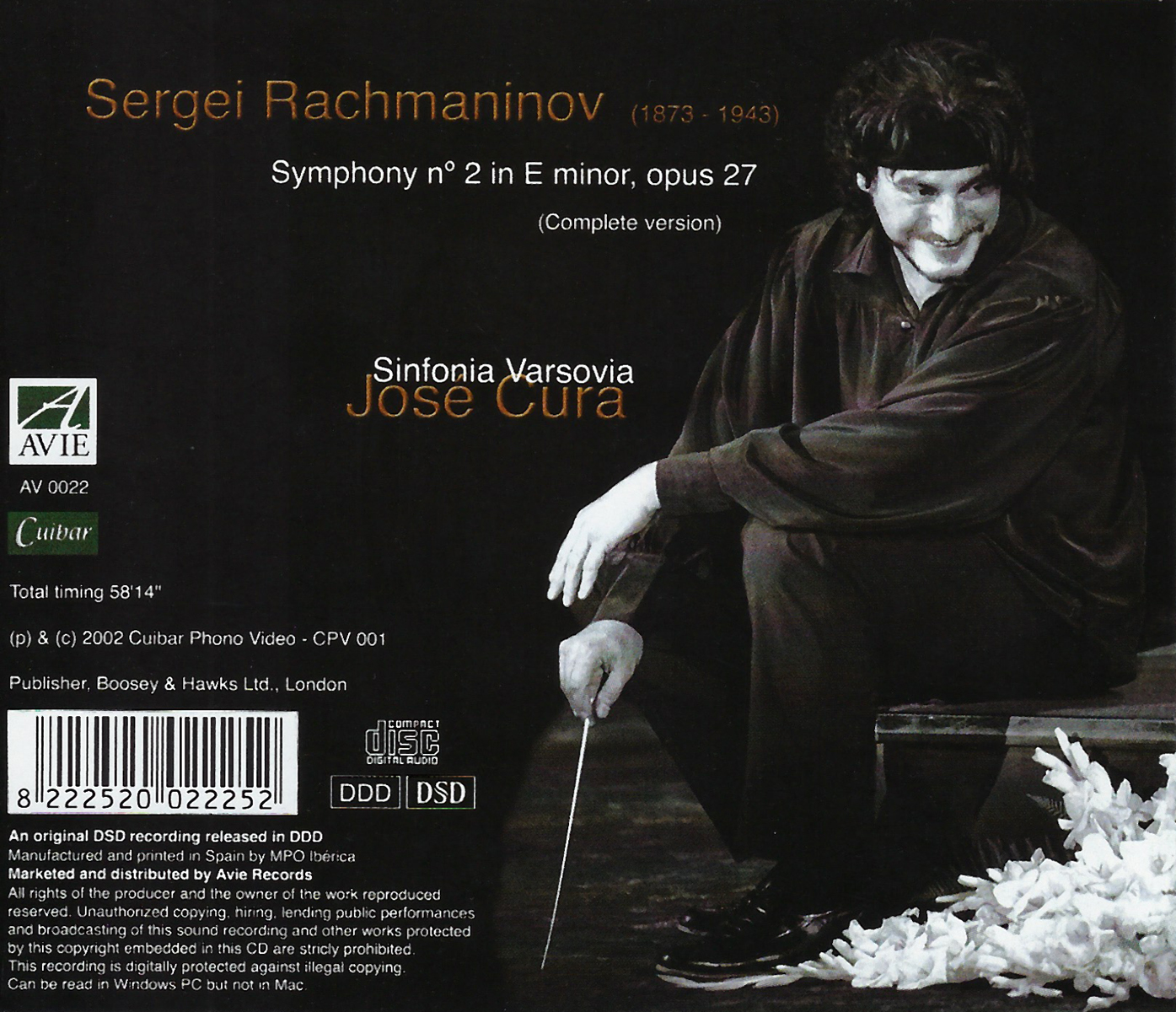Digital Download Available!
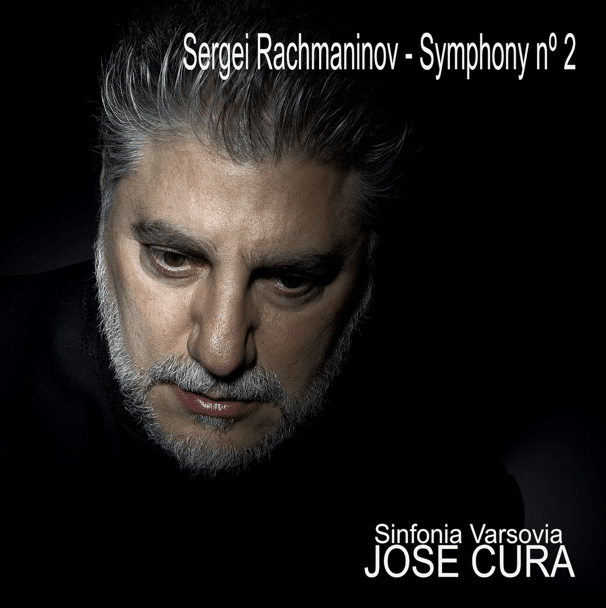 |
José Cura’s acclaimed rendition of Rachmaninov 2nd Symphony in E minor, Op. 27, is now available for digital download. José has remastered the original recording, applying modern technical improvements that make the new release pop with clarity and color. The symphony is presented without the usual cuts, giving the listener the chance to hear this popular, beloved symphony as intended, with the composer’s genius in melodic invention and rich orchestration showcased. “A performance you imagined but never dreamed you would experience: fast and powerful, impressive, vivacious. Great Rachmaninov playing.” Classical Music Web
Available on all major online platforms including Google Play, Spotify, Amazon.... |
|
Artist of the Month: José Cura RECORDGEIJUTSU Vol.52 NO.651 Apr 2003 N-Matsuoka José Cura visited Japan in January this year [2003] to sing the title role in the Teater Wielki (Warsaw, Poland) production of Verdi’s opera ‘Otello,’ and he won vigorous applause. On one hand, Cura is probably one of the best known singer of the post Three-Tenor generation; on the other hand, readers are probably surprised to learn that he is the principle guest conductor of the Sinfonia Varsovia and that the Rachmaninov Symphony No.2 he recorded with his own production company (Cuibar) and released through AVIE was the specially selected disc in our February issue. This interview took place during the interval of the Otello performance on January 14 and focuses primarily on José Cura as a conductor. NM--Would you tell us about the start of your professional relationship with Sinfonia Varsovia? José Cura---I visited Warsaw in 2000 for a concert to promote a new CD. I had the opportunity to perform with Sinfonia Varsovia. From the first encounter, it felt very good, very natural. Then the orchestra asked me to become the principle guest conductor and I took the office in 2001. From the beginning we had a close affinity and performed many concerts in 2002. We also recorded and released two CDs. [Aurora, a recital disc, and Rachmaninov’s Symphony No. 2. (ed.)] Last year, we recorded a live version of BeethovenNo.9 in November and we expect to be able to release it next year. NM--Are there many young people among the members of orchestra? JC---It varies. There is a young person and there is a person who is not so (laugh). They are about 45 years old on an average. NM-- Although Rachmaninov Symphony No.2 is a big, passionate number, why was this number important for you to put on a CD at this time? JC--- When I was first invited to be the principle guest conductor of this orchestra, I had to decide on the repertory of our concerts. I asked what number the symphony had not yet performed. That is, I thought that it would be wonderful if we started with something strange and new to both of us. Since the orchestra had not previously performed the Rachmaninov Symphony No 2., this was put on our program. Of course, it was not the only piece. We performed the symphonic poem ‘Pini di Rome’ by Respighi, ‘Dances of Galánta’ by Kodaly, and so on. NM-- Didn't you conduct Rachmaninov Symphony No2 for the first time in the concert in Warsaw? JC--- That's right. It was also my [symphonic] conducting debut. Of course, there was a purpose in this and I wanted to share this first experience with everyone. NM-- Although it was very adventurous selection in a certain meaning, do I hear that that fresh performance was produced as the result? Some conductors cut out a repetitive portion the first movement .. but you did not. What do you find is the charm of this work? JC--- As for the portion which I very like with this number, passion is just something that is felt very strongly from the overture of the first movement. I did not want at all to express the romantic feeling as so many have. Although it seems that many conductors are keeping the elegant approach of the French style in mind, I performed Rachmaninov as the composer, a very passionate Russian, would have. I have heard comments that hearing our recording is like sitting on the edge of your chair from the beginning to the end, and having the feeling of tension that cannot be relaxed. NM--I understand perfectly the reason for that comment. Although there is a peculiar feeling of high tension, is that also because of the short recording time? JC--- Recording was intensively performed in 4 sessions so that the freshest possible feeling could be caught. When there is too much time, recording in studio allows correction after correction, since a perfect performance is expected, and too many repairs make the performance petty. We tried to avoid that. Since this is the first symphony recording for me, maybe after a number of years it will become a collector’s item. Since ‘the thing’ is a thing only once, the first time. I think it is a record that will be available only to those who buy it now. It is the same with the opera I first recorded, the opera ‘Le villi’ by Puccini that was released in 1995. After about ten years have passed, it is not easy to get one in hand. Of course, since I was an obscure performer in those days, did those who considered the performance a good one buy the CD to say it was nice to own?
NM-- When the orchestra increased the number of performances conducted by José Cura, does the performance itself change too?
JC--- Of course it changes. On November 29, we performed Rachmaninov Symphony No.2 together in the Vienna Concert house. As you know, this is a traditional music hall. At the end of the performance –from the back arose applause and the audience gave us a standing ovation. I remember hearing that it is very difficult to obtain such a result in Vienna, although it has since been written "José Cura is a great conductor who sings occasionally" (laugh). Of course, it is usually written, "Cura is a great vocalist who also conducts occasionally." I am very happy that this time it was written in reverse.
NM-- The credit "In Memoriam Maestro Luis Garcia Navarro" was contained in the Rachmaninov disk. Would you tell us about your relationship, since Mr. Navarro was very familiar for Japanese music fan, since he often conducted the Tokyo Philharmonic?
JC--- When I debuted in the opera ‘Tosca’ by Puccini in 1995, Garcia Navarro was conducting. The friendship started from this time, and when I sang ‘Aida’ by Verdi at New National Theater of Tokyo for the first time in 1998, he was conducting. We became good friends and when my family and I moved from Paris to Madrid three years ago, he made all arrangements for the house and so on. I thought of him as one of my best friends and wished to dedicate this CD to him very much. And I would like you to tell the readers that he left the world without knowing I had been asked to be principle guest conductor. Two weeks after his death I was appointed and then planned to perform Rachmaninov. Two weeks before the concert, I visited his house to extend condolences. I was actually sitting in his living room. All the scores he possessed were arranged precisely and located in a row. Only the score for Rachmaninov Symphony No.2 was out of place. Of course, since he did not know that I would conduct the music and his widow did not know, either, I felt he was transmitting some absurd big message to me.
NM-- It is a moving episode in which one feels something of fate.
JC--- Yes. That is right.
NM-- Will the pace of your conducting activities increase from now on?
JC--- I think that this situation is the same as that of the coach of soccer, or the choreographer of ballet. In many cases, the coach is an older man who played the game when young. But with the passing years, the play becomes impossible and so he becomes a coach -- I think that my conducting is like that.
Of course, although I like to conduct, I think singing is my main job now. I will turn my attention to conducting full time when I am old and it becomes impossible to sing—like the coach to soccer when no longer young. But I think that I want to carry on with both for now.
NM--What you just said probably relieved many of your fans. By the way, although we talked of Beethoven No.9 earlier, doesn't the tenor who sings under a great singer's baton like Mr. Cura become tense at all?
JC--- When I conducted it, I told the tenor the exact opposite. "There will be no other performance with this sense of security.” I told him that I could hear all the problems that a tenor would have and that he should feel very much at ease and be able to sing while I breathed with him while I conducted. Of course, he may have felt tense in the first rehearsal. But during the rehearsal, I let it go so it would be no different than with an ordinary conductor who does not sing.
NM-- I see. And this conversation brings up the question as to whether there are conductors who are easy to sing for and those who are hard to sing for?
JC--- It is always good to sing for a conductor who is good, for if you sing for one who is not so good, then surely there is a problem. It is the way of life itself. (laugh).
NM-- This is a wise saying –(laugh). I have heard that ‘Cancion a la Bandera’ recorded on "Aurora" is special.
JC--- For all Argentineans, this is important music and the music next in importance to the national anthem.
NM-- Although the opera ‘Siberia’ Prelude (act 2) of Giordano was an interesting work with the inclusion of the fragment of ‘Song of the Volga Boatman’, do you it have feelings against Giordano?
JC--- This number was the first also for me. I like to always take in the newest possible work in a concert or CD. It seems that almost no one knows ‘Siberia’. I think that it is very forcible and dramatic music.
I dared to include the prelude because I thought that it was what those who are hearing it would tend to hold on to as a whole image, since the theme of aria appears in it.
NM-- Can you tell us about the choral repertory you conducted during your university enrollment?
JC--- It has been over 20 years -- although I don’t remember details there is a memory of conducting ‘Matthaus Passion’ by Bach, and Gesualdo and Palestrina.
NM-- Do you plan to continue to record with Sinfonia Varsovia?
JC--- It depends on the sales of the first two disks. If it seems that the CDs sell enough to cover the capital expended on the cost for their recording, I will go on with the next recording. If they cannot sell enough, then it will be difficult. Since you started the conversation, if you make sure you write to your audience conspicuously to "buy it by all means," I will be happy. (laugh).
NM--This has already been carried out and the Rachmaninov starred as the specially selected disk for our magazine. Many fans will surely purchase it. By the way, whose idea was it to include the big posters with the CDs?
JC---I am the graphic designer for both disks. I am also a photographer. Surely, although it is a very new idea that a poster is contained in a classical music CD, it is nice for the audience to have a good CD in hand and a poster to follow.
I don’t think it is necessary to indicate all of the history of an aria, the performance history of the music, a composer's whole life, etc. in the liner notes. You understand, if the music is mostly known or a book is available or is on the Internet. On the other hand, it is the artist’s portrait that most people do not have. Although this is a technique most often used in the pop market, I thought it would be a good thing to try.
The bonus track in which rehearsal scenes are replayed is included in "Aurora." In classical music, it may be new -- (Cura spoke while opening the liner notes of "Aurora" which the writer brought). Although the graphics work station is in my house [in Spain], Aurora is offered to my country, so the design concept is the national flag of Argentina. This yellow color is the same as the sun of the national flag of Argentina.
NM---- The color coordination is splendid.
JC--- The color here is the same color as the cover, and all are connected. (Cura turns over the page of liner notes carefully) This is a photograph in Teatro alla Scala of Milan. After this comes the only explanatory note of this album. Since people do not know many things about Panizza who is the composer of ‘Cancion a la Bandera,’ it was necessary to add something about him.
NM----- A pleasant talk -- thank you
Editorial note: Due to the difficulties in translating from the original Japanese to English, this is not a literal translation. Every effort has been made to represent the comments by both the writer and the artist correctly.
|
